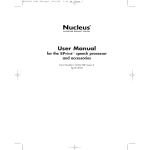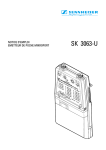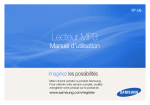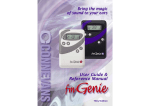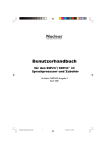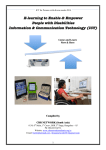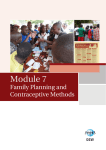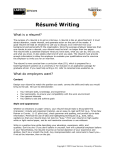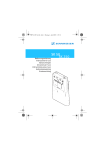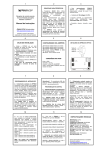Download User manual - ESPrit/22 sound processor and accessories
Transcript
User Manual for the ESPrit / ESPrit 22 speech processor and accessories TM TM Part Number: N02323F Issue 3 April 2000 Nucleus is a registered trademark of Cochlear Limited. ESPrit is a trademark of Cochlear Limited. N02323F ISS3 APR2000 (DRAFT 12) N02323F ISS3 APR2000 (DRAFT 12) Contents Introduction About this Manual . . . . . . . . . . . . . . . . . . . . . . . . . . . . . . . . . . . . . . . .5 The Cochlear Implant System . . . . . . . . . . . . . . . . . . . . . . . . . . . . . . .6 The ESPrit Speech Processor . . . . . . . . . . . . . . . . . . . . . . . . . . . . . . . .7 Features . . . . . . . . . . . . . . . . . . . . . . . . . . . . . . . . . . . . . . . . . . . . . . .7 Nucleus 24 ESPrit and ESPrit 22 . . . . . . . . . . . . . . . . . . . . . . . . . . . .8 Controls . . . . . . . . . . . . . . . . . . . . . . . . . . . . . . . . . . . . . . . . . . . . . . .9 Function Switch . . . . . . . . . . . . . . . . . . . . . . . . . . . . . . . . . . . . . . . .10 Rotary Control . . . . . . . . . . . . . . . . . . . . . . . . . . . . . . . . . . . . . . . . .11 The Transmitting Coil . . . . . . . . . . . . . . . . . . . . . . . . . . . . . . . . . . . .12 Accessories . . . . . . . . . . . . . . . . . . . . . . . . . . . . . . . . . . . . . . . . . . . .13 Using the System Battery Cover . . . . . . . . . . . . . . . . . . . . . . . . . . . . . . . . . . . . . . . . . .15 Opening the Battery Cover . . . . . . . . . . . . . . . . . . . . . . . . . . . . . . . .16 Closing the Battery Cover . . . . . . . . . . . . . . . . . . . . . . . . . . . . . . . . .17 Batteries . . . . . . . . . . . . . . . . . . . . . . . . . . . . . . . . . . . . . . . . . . . . . .18 Replacing the Batteries . . . . . . . . . . . . . . . . . . . . . . . . . . . . . . . . . . .19 Connecting the Transmitting Coil . . . . . . . . . . . . . . . . . . . . . . . . . . .20 Connecting the Cable to the ESPrit . . . . . . . . . . . . . . . . . . . . . . . . . .21 Connecting the Cable to the Transmitting Coil . . . . . . . . . . . . . . . . .21 Fitting the ESPrit . . . . . . . . . . . . . . . . . . . . . . . . . . . . . . . . . . . . . . . .22 Placing the Transmitting Coil . . . . . . . . . . . . . . . . . . . . . . . . . . . . . .22 Adjusting the Magnet . . . . . . . . . . . . . . . . . . . . . . . . . . . . . . . . . . . .22 Changing the Magnet . . . . . . . . . . . . . . . . . . . . . . . . . . . . . . . . . . . .23 Selecting a Program . . . . . . . . . . . . . . . . . . . . . . . . . . . . . . . . . . . . . .24 Adjusting the ESPrit Controls . . . . . . . . . . . . . . . . . . . . . . . . . . . . . .25 Adjusting the Volume . . . . . . . . . . . . . . . . . . . . . . . . . . . . . . . . . . . .25 Adjusting the Microphone Sensitivity . . . . . . . . . . . . . . . . . . . . . . . .25 Autosensitivity Option . . . . . . . . . . . . . . . . . . . . . . . . . . . . . . . . . . . .26 Locked Option . . . . . . . . . . . . . . . . . . . . . . . . . . . . . . . . . . . . . . . . .26 Battery Power Consumption . . . . . . . . . . . . . . . . . . . . . . . . . . . . . . .26 ESPrit User Manual ◆ 3 N02323F ISS3 APR2000 (DRAFT 12) Accessories Mixing . . . . . . . . . . . . . . . . . . . . . . . . . . . . . . . . . . . . . . . . . . . . . . .30 Audio Accessories . . . . . . . . . . . . . . . . . . . . . . . . . . . . . . . . . . . . . . .31 Connecting the Accessories . . . . . . . . . . . . . . . . . . . . . . . . . . . . . . . .32 Connecting Audio Accessories . . . . . . . . . . . . . . . . . . . . . . . . . . . . . .32 Changing from one Audio Accessory to another . . . . . . . . . . . . . . . .33 Using the Audio Accessories . . . . . . . . . . . . . . . . . . . . . . . . . . . . . . .34 Lapel Microphone . . . . . . . . . . . . . . . . . . . . . . . . . . . . . . . . . . . . . . .34 Lapel Clip . . . . . . . . . . . . . . . . . . . . . . . . . . . . . . . . . . . . . . . . . . . . .35 Ear Hooks . . . . . . . . . . . . . . . . . . . . . . . . . . . . . . . . . . . . . . . . . . . . .35 Telecoil . . . . . . . . . . . . . . . . . . . . . . . . . . . . . . . . . . . . . . . . . . . . . . .36 FM Cable: Nucleus 24 ESPrit . . . . . . . . . . . . . . . . . . . . . . . . . . . . . .38 FM Cable: ESPrit 22 . . . . . . . . . . . . . . . . . . . . . . . . . . . . . . . . . . . . .40 Accessory Adaptor Cable . . . . . . . . . . . . . . . . . . . . . . . . . . . . . . . . . .42 TV/Hi-Fi Cable . . . . . . . . . . . . . . . . . . . . . . . . . . . . . . . . . . . . . . . . .43 Personal Audio Cable . . . . . . . . . . . . . . . . . . . . . . . . . . . . . . . . . . . .44 Troubleshooting Accessories . . . . . . . . . . . . . . . . . . . . . . . . . . . . . . .45 Monitor Earphones . . . . . . . . . . . . . . . . . . . . . . . . . . . . . . . . . . . . . .45 Signal Check . . . . . . . . . . . . . . . . . . . . . . . . . . . . . . . . . . . . . . . . . . .46 Dry Pack . . . . . . . . . . . . . . . . . . . . . . . . . . . . . . . . . . . . . . . . . . . . . .47 Caring for Your ESPrit Storing Your ESPrit . . . . . . . . . . . . . . . . . . . . . . . . . . . . . . . . . . . . . .49 Cleaning Your ESPrit . . . . . . . . . . . . . . . . . . . . . . . . . . . . . . . . . . . . .49 Removing Excess Moisture . . . . . . . . . . . . . . . . . . . . . . . . . . . . . . . .50 Troubleshooting . . . . . . . . . . . . . . . . . . . . . . . . . . . . . . . . . . . . . . . .52 Procedures for Identifying Problems . . . . . . . . . . . . . . . . . . . . . . . . .52 Warnings and Precautions Warnings . . . . . . . . . . . . . . . . . . . . . . . . . . . . . . . . . . . . . . . . . . . . . .57 Precautions . . . . . . . . . . . . . . . . . . . . . . . . . . . . . . . . . . . . . . . . . . . .61 General Information Technical Information . . . . . . . . . . . . . . . . . . . . . . . . . . . . . . . . . . . .65 Specifications . . . . . . . . . . . . . . . . . . . . . . . . . . . . . . . . . . . . . . . . . .65 Operating Characteristics . . . . . . . . . . . . . . . . . . . . . . . . . . . . . . . . .66 Registration . . . . . . . . . . . . . . . . . . . . . . . . . . . . . . . . . . . . . . . . . . . .68 Certification and Applied Standards . . . . . . . . . . . . . . . . . . . . . . . . . .68 International Labelling Symbols . . . . . . . . . . . . . . . . . . . . . . . . . . . . .69 4 ◆ ESPrit User Manual N02323F ISS3 APR2000 (DRAFT 12) Introduction About This Manual This manual is intended for users of the Nucleus® cochlear implant, the ESPritTM and ESPritTM 22 speech processors. It may also assist others such as caregivers and teachers involved with children who are implant recipients. In this manual, the term ‘ESPrit’ refers to both: • the ESPrit speech processor for the Nucleus 24 cochlear implant and • the ESPrit 22 speech processor for the Nucleus 22 cochlear implant. Where differences exist, ESPrit information is presented under the heading, ‘Nucleus 24 ESPrit’ or ‘ESPrit 22’. The manual contains: • Information about the cochlear implant system • Instructions on fitting, using and caring for the ESPrit and accessories • Basic troubleshooting guide ESPrit User Manual ◆ 5 N02323F ISS3 APR2000 (DRAFT 12) I N T R O D U C T I O N • Warnings and precautions • Technical information The operation of the implanted components of the Nucleus system is not described in this manual. Please contact your implant surgeon or implant centre if you require information about implanted components. The Cochlear Implant System The Nucleus cochlear implant system consists of three parts: • Cochlear implant • Speech processor • Transmitting coil These three parts work together to produce a hearing sensation. Sound is received by the microphone in the speech processor. The speech processor selects and codes useful sounds and sends them to the transmitting coil. The transmitting coil sends the code to the implanted unit, which converts the code into electrical signals. The electrical signals are sent to the electrodes, which stimulate the hearing nerve fibres in the cochlea. In turn, these fibres transmit the sound signal to the brain for interpretation. 6 ◆ ESPrit User Manual N02323F ISS3 APR2000 (DRAFT 12) I N T R O D U C T I O N The ESPrit Speech Processor TM The ESPrit speech processor is a small lightweight device. It is worn behind the ear. ➤ ➤ ➤ ➤ Microphone ports Volume/ sensitivity control ➤ ➤ Ear hook Function switch ➤ Battery cover Transmitting cable The ESPrit speech processor Features The ESPrit speech processor incorporates the following features: • A built-in microphone • Two listening programs, which can be customised for different listening situations • Option of microphone sensitivity or volume control for each program • Programmable autosensitivity option • Audio cover with external input socket that allows the ESPrit to accept signals directly from other devices ESPrit User Manual ◆ 7 N02323F ISS3 APR2000 (DRAFT 12) I N T R O D U C T I O N Nucleus 24 ESPrit and ESPrit 22 Your clinician will tell you which model ESPrit speech processor is appropriate for your implant. The ESPrit 22 has ‘ESPrit 22’ marked on the spine, whereas the the Nucleus 24 ESPrit is unmarked. Nucleus 24 ESPrit ESPrit 22 8 ◆ ESPrit User Manual N02323F ISS3 APR2000 (DRAFT 12) I N T R O D U C T I O N Controls The ESPrit is controlled by • A function switch • A rotary control Both of these controls are located on the spine of the ESPrit. ➤ ➤ Rotary control Function switch ESPrit controls ESPrit User Manual ◆ 9 N02323F ISS3 APR2000 (DRAFT 12) I N T R O D U C T I O N Function Switch The switch positions are: • P1 Program 1 • P2 Program 2 • 0 Off Switch positions Your clinician can create two programs for you to use in different listening situations. 10 ◆ ESPrit User Manual N02323F ISS3 APR2000 (DRAFT 12) I N T R O D U C T I O N Rotary Control The rotary control can be programmed by your clinician so that: • it can control microphone sensitivity • it can control volume with microphone sensitivity set at a fixed level • it can be locked for children Rotary control positions For each program there is the option of using microphone sensitivity, using volume control, or locking the control. Your clinician will advise you on the best control for you. Your clinician may also program your ESPrit with the autosensitivity option. ESPrit User Manual ◆ 11 N02323F ISS3 APR2000 (DRAFT 12) I N T R O D U C T I O N The Transmitting Coil The transmitting coil is attached to the ESPrit by the transmitting cable, and is held securely in place by magnetic attraction between a magnet in the coil and a magnet in the implanted unit. ➤ Transmitting coil ➤ Magnet ➤ Transmitting cable The transmitting coil Note: Your transmitting coil may look slightly different to the one shown. 12 ◆ ESPrit User Manual N02323F ISS3 APR2000 (DRAFT 12) I N T R O D U C T I O N Accessories Cochlear offers a wide range of ESPrit accessories designed for a variety of different listening situations. • Telecoil • Lapel Microphone • TV/Hi-Fi cable • Personal audio cable • FM cable • Lapel clip • Ear hooks These accessories may not be available in all regions. Please contact your cochlear implant centre if you have questions about their availability. Note: A detailed account of the accessories is given on page 29. ESPrit User Manual ◆ 13 N02323F ISS3 APR2000 (DRAFT 12) 14 ◆ ESPrit User Manual N02323F ISS3 APR2000 (DRAFT 12) Using the System At the initial programming session, your clinician will show you the following procedures: • Opening and closing the battery cover • Removing and inserting batteries • Replacing the transmitting coil • Fitting the ESPrit™ and transmitting coil • Switching the ESPrit on • Selecting the appropriate program • Adjusting the microphone sensitivity or volume These procedures are described in detail below. Battery Cover You need to know how to open and close the battery cover so that you can: • Replace the batteries • Replace the transmitting cable • Attach the audio cover and accessories ESPrit User Manual ◆ 15 N02323F ISS3 APR2000 (DRAFT 12) U S I N G T H E S Y S T E M Opening The Battery Cover 1. Make sure that the ESPrit is switched off. 2. Use the thumb and forefinger from one hand to hold the main body of the ESPrit and the thumb and forefinger of the other hand to hold the battery cover. 3. Put your thumbnail in one of the indentations located on each side of the ESPrit and pull gently to release the battery cover. 4. Gently rotate the battery cover away from the ESPrit. Rotating the battery cover open 16 ◆ ESPrit User Manual N02323F ISS3 APR2000 (DRAFT 12) U S I N G T H E S Y S T E M 5. Once you have opened the battery case to about 90˚, remove the cover completely. ESPrit with battery cover removed Closing the Battery Cover 1. Line up the hinge of the battery cover with the pin at the base of the ESPrit. 2. Make sure that the cable is lying in the groove at the base of the ESPrit. Pin Hinge Closing the battery cover ESPrit User Manual ◆ 17 N02323F ISS3 APR2000 (DRAFT 12) U S I N G T H E S Y S T E M 3. Close the battery cover carefully, checking that the cable exits at the base of the ESPrit. You may need to hold the batteries in place so that they do not obstruct the cover. Note: To prevent damage to the ESPrit from electrostatic discharge, do not leave the battery cover open for long periods of time or pass the ESPrit to another person while the battery cover is open. Batteries The ESPrit is powered by two hearing aid batteries. Cochlear recommends High Power 675 Zinc Air batteries, but Silver Oxide S76 batteries can also be used, particularly in humid or very cold conditions. Rechargeable batteries are not available. Warning: Batteries can be harmful if swallowed. Ensure that batteries are kept out of reach of young children. If swallowed, seek prompt medical attention at the nearest emergency centre or poisons information centre. While it is switched on, the ESPrit is continually checking the battery voltage level. It emits short warning beeps when the battery voltage is low. When the battery voltage is very low, the ESPrit stops operating. ESPrit 22 The warning beeps may also sound in situations where there is loud noise. 18 ◆ ESPrit User Manual N02323F ISS3 APR2000 (DRAFT 12) U S I N G T H E S Y S T E M Replacing the Batteries When replacing the batteries, always work over a table or counter top so that the batteries can be easily found if if they are accidentally dropped. 1. Switch the ESPrit off. 2. Open the battery cover as described at the beginning of this section. 3. Remove the old batteries by holding the ESPrit with the batteries facing downward. You may need to release the batteries by pushing them out from behind using a pointed object such as a pen. Removing the batteries 4. The tabs on new zinc air batteries should be removed before use. It is important to wait one minute after removing the tabs before placing the batteries in the ESPrit. This allows an initial chemical reaction in the batteries to take place. Without it, the ESPrit will be under powered and may exhibit intermittent operation. ESPrit User Manual ◆ 19 N02323F ISS3 APR2000 (DRAFT 12) U S I N G T H E S Y S T E M 5. Insert the batteries with the positive (+) flatter sides face up. Batteries shown with the positive flatter sides face up 6. Push the battery cover back into place. See ‘Closing the Battery Cover’. Do not leave old batteries in the ESPrit as they may leak corrosive fluids which could damage the ESPrit. Batteries must be disposed in accordance with your local environmental requirements. Connecting the Transmitting Coil The transmitting coil is connected to the ESPrit by the transmitting cable, which is available in various lengths, in beige, brown and black. A short cable can be used when you wear the ESPrit on the same side of your head as the implant. A longer cable can be used if you wear the ESPrit on the other side of your head. Choose the cable most comfortable for you. 20 ◆ ESPrit User Manual N02323F ISS3 APR2000 (DRAFT 12) U S I N G T H E S Y S T E M Connecting the Cable to the ESPrit 1. Open the battery cover. See ‘Opening the Battery Cover’. 2. Insert the smaller plug on the transmitting cable into the connector on the ESPrit. This connector is exposed when the battery cover is removed. 3. Make sure that the cable is lying in the groove at the base of the ESPrit. Attaching the cable to the ESPrit 4. Close the battery cover carefully making sure that the cable exits at the base of the ESPrit. Connecting the Cable to the Transmitting Coil 1. Insert the larger plug on the cable into the socket on the transmitting coil. 2. Make sure that the cable is firmly connected. ESPrit User Manual ◆ 21 N02323F ISS3 APR2000 (DRAFT 12) U S I N G T H E S Y S T E M Fitting the ESPrit There are two sizes of ear hook that can be screwed onto the ESPrit. Choose the size that is the most comfortable for you. Fit the ESPrit ear hook over your ear so that it is in the most comfortable position. Placing the Transmitting Coil Place the transmitting coil on your head over the implant. It is held in place by magnetic attraction between a magnet in the coil and a magnet in the implanted unit. The ESPrit should only be switched on when your transmitting coil is in place. Each time you use your ESPrit ensure that the transmitting coil is in place before switching it on; and always switch the ESPrit off before removing the transmitting coil. Adjusting the Magnet The magnet in the coil may be adjusted for your comfort by your clinician, but you may want to make a small adjustment. Magnet ➤ Adjusting the magnet 22 ◆ ESPrit User Manual N02323F ISS3 APR2000 (DRAFT 12) U S I N G T H E S Y S T E M If the magnet is too strong, it may cause discomfort or skin irritation. To hold the coil less firmly against your head, turn the magnet counterclockwise. If the magnet is too weak, the coil may fall off. To hold the coil more firmly against your head, turn the magnet clockwise. Changing the Magnet Cochlear supplies the transmitting coil with a standard strength magnet but a number of alternative strength magnets are available. Consult your clinician before choosing a magnet of a different strength. To remove the magnet, turn it counter-clockwise. Insert the replacement magnet and turn it clockwise to a stable and comfortable position. Changing the magnet In some cases, to keep the required magnetic force to a minimum, you may occasionally need to trim or shave your hair in the area over the implant to about 6 mm (4 in.) or less. The patch of trimmed hair can be concealed by the rest of your hair. Ask your clinician to teach you how to do this or contact your implant centre for advice. ESPrit User Manual ◆ 23 N02323F ISS3 APR2000 (DRAFT 12) U S I N G T H E S Y S T E M Selecting a Program The ESPrit can store up to two programs at any one time, enabling your clinician to optimise programs for different listening environments. These programs are labelled on your ESPrit as P1 and P2. Switch positions To change programs, move the switch on the spine of the ESPrit up or down accordingly. The ESPrit should only be switched on when your transmitting coil is in place. Each time you use your ESPrit ensure that the transmitting coil is in place before switching it on; and always switch the ESPrit off before removing the transmitting coil. 24 ◆ ESPrit User Manual N02323F ISS3 APR2000 (DRAFT 12) U S I N G T H E S Y S T E M Adjusting the ESPrit Controls Each program features a microphone sensitivity or a volume control. Your clinician will advise you of the choice most suitable for you and will program your ESPrit accordingly. Your clinician will tell you the approximate range of microphone sensitivity or volume you should use. Rotary control positions Adjusting the Volume The volume controls your perception of loudness. You can reduce the volume if loud sounds are too loud or increase the volume if speech, including your own voice, is too soft. To adjust the volume, turn the rotary control until you find a comfortable listening level. If you adjust the volume or microphone sensitivity setting often, or such adjustments cause you discomfort, consult your clinician as the programs in your ESPrit may need adjustment. Adjusting the Microphone Sensitivity The microphone sensitivity controls the softest level of sound picked up by the microphone. You ESPrit User Manual ◆ 25 N02323F ISS3 APR2000 (DRAFT 12) U S I N G T H E S Y S T E M can decrease the microphone sensitivity to filter out background noise, or increase the microphone sensitivity in quiet environments to hear very soft sounds. Adjust the rotary control until sounds are heard most clearly. Autosensitivity Option If your clinician has programmed your ESPrit with the autosensitivity option, you will notice that the microphone sensitivity will decrease automatically in a noisy environment. Locked Option Alternatively, there is the option for the clinician to lock the rotary control for children, if required. Battery Power Consumption The ESPrit uses power whenever it is on, even if you are not using it. In addition, the ESPrit automatically shuts down if it does not receive sufficient power from the battery. This can happen when you move from a quiet to a noisy environment, or when there is a sudden change of temperature or humidity, or when the batteries are near the end of their useful life. Battery life depends on many factors such as the amount of noise in your environment, the number of hours you use the ESPrit each day, and the brand and type of battery. 26 ◆ ESPrit User Manual N02323F ISS3 APR2000 (DRAFT 12) U S I N G T H E S Y S T E M Nucleus 24 ESPrit High Power 675 zinc air batteries can power the ESPrit for 30 to 80 hours, silver oxide batteries have a significantly shorter life and should only be used when zinc air batteries are not appropriate. ESPrit 22 High Power 675 zinc air batteries can power the ESPrit 22 for 20 to 50 hours, silver oxide batteries have a significantly shorter life and should only be used when zinc air batteries are not appropriate. Power consumption is much higher in noisy situations and the ESPrit 22 may emit warning beeps. If this occurs you have the option of changing the batteries or checking the function of the ESPrit 22 in a quiet location. The ESPrit should only be switched on when your transmitting coil is coupled to your implant. Each time you use your ESPrit ensure that the transmitting coil is in place before switching the ESPrit on; and switch the ESPrit off before removing the transmitting coil. ESPrit User Manual ◆ 27 N02323F ISS3 APR2000 (DRAFT 12) 28 ◆ ESPrit User Manual N02323F ISS3 APR2000 (DRAFT 12) Accessories Cochlear offers a wide range of ESPrit™ accessories designed for a variety of different listening situations. Lapel microphone The lapel microphone improves communication in noisy situations. Telecoil The telecoil is for use with a hearing aid compatible telephone or in a room with an induction loop system. TV/Hi-Fi cable The TV/Hi-Fi cable is for use with equipment that is powered from a wall outlet, particularly a TV, stereo or personal computer. Personal audio cable The personal audio cable is for use with battery powered equipment such as a personal stereo. FM cable The FM cable is for use with FM listening systems. ESPrit User Manual ◆ 29 N02323F ISS3 APR2000 (DRAFT 12) A C C E S S O R I E S In order to connect these accessories, Cochlear supplies an Audio Cover, which should be attached to the ESPrit in place of the battery cover. To connect the TV/Hi-Fi cable and the personal audio cable, an Accessory Adaptor Cable is supplied. Other accessories for the ESPrit include the Ear Hook, Lapel Clip, Dry Pack, Monitor Earphones and Signal Check. Mixing The connection of some audio accessories disables the microphone in the ESPrit so that the sound you hear comes only from the accessory. However, for most audio accessories the sound from the ESPrit microphone can be heard in addition to the sound from the accessory. In this case, the proportion of sound from the ESPrit microphone can be adjusted (and reduced to zero) with the rotary control. This is known as ‘mixing’. Adjust the rotary control to obtain a good balance between the sources of sound. To hear more sound from the ESPrit microphone, turn up the rotary control; to hear less sound from the ESPrit microphone, turn down the rotary control. Mixing is available for the FM cable, TV/Hi-Fi cable and personal audio cable. 30 ◆ ESPrit User Manual N02323F ISS3 APR2000 (DRAFT 12) A C C E S S O R I E S Audio Accessories ESPrit (with battery cover removed) Audio Cover Telecoil Lapel Microphone FM Cable Accessory Adaptor Cable TV/Hi-Fi Cable Personal Audio Cable ESPrit microphone enabled: Mixing is available (if the ESPrit is programmed for sensitivity) ESPrit microphone disabled ESPrit User Manual ◆ 31 N02323F ISS3 APR2000 (DRAFT 12) A C C E S S O R I E S Connecting the Accessories Connecting audio accessories 1 2 Ensure that the ESPrit is off. Remove the battery cover. 3 Fit the audio cover to the ESPrit by lining up the hinge with the pin at the base of the ESPrit and closing the cover carefully. 4 Connect the audio accessory into the base of the audio cover. For the accessory adaptor cable, plug the connector into the audio cover. Specific instructions for each audio accessory are given in the following pages. Do not switch the ESPrit on until the audio cover is completely closed, the accessory cable is connected, and the transmitting coil is in place. 32 ◆ ESPrit User Manual N02323F ISS3 APR2000 (DRAFT 12) A C C E S S O R I E S Changing from one audio accessory to another 1 2 Switch the ESPrit off. Remove the ESPrit and transmitting coil. 3 Disconnect the attached audio accessory. 4 Connect the desired audio accessory into the base of the audio cover. For the accessory adaptor cable, plug the connector into the audio cover. Specific instructions for each audio accessory are given in the following pages. Do not switch the ESPrit on until the audio cover is completely closed, the accessory cable is connected, and the transmitting coil is in place. ESPrit User Manual ◆ 33 N02323F ISS3 APR2000 (DRAFT 12) A C C E S S O R I E S Using the Audio Accessories Lapel Microphone The lapel microphone can improve communication in noisy situations. 1. Switch the ESPrit off. 2. Remove the ESPrit. 3. Remove the battery cover from the ESPrit and fit the audio cover. If the audio cover is already in place, remove any accessory cable that may be attached. 4. Connect the lapel microphone to the base of the audio cover. 5. Fit the ESPrit to your ear and place the transmitting coil over the implant. 6. Switch the ESPrit on. When talking to one person, try clipping the microphone to their clothing with the lapel clip. When talking in a small group, either pass the microphone from speaker to speaker or place the microphone on the table. If you pass the microphone around, hold it no more than 10 cm (4 in.) from the speaker and point it toward the speaker’s mouth. Note: If unwanted background noise is experienced when using the lapel microphone, please contact your clinician who may recommend reprogramming your ESPrit. 34 ◆ ESPrit User Manual N02323F ISS3 APR2000 (DRAFT 12) A C C E S S O R I E S Lapel Clip The lapel clip can be used as a guide for the lapel microphone cable or the accessory cable by placing the cable in the clip and attaching the clip to your clothing. The lapel clip can also be used to hold the accessory or lapel microphone cable securely in one position. 1. Remove the rubber band from the lapel clip and slide the rubber ring over the cable. 2. Attach the rubber band to the lapel clip by looping it twice around the inner slot. Looping the rubber band around the lapel clip 3. Gently pull the cable through the jaws of the clip to fit in the same slot as the rubber band. Fitting the cable into the lapel clip 4. Attach the clip to your clothing. Ear Hooks Ear hooks come in two sizes, large for adults and small for children. They can be unscrewed from the ESPrit and replaced. ESPrit User Manual ◆ 35 N02323F ISS3 APR2000 (DRAFT 12) A C C E S S O R I E S Telecoil The telecoil can be used with a hearing aid compatible telephone or in a room fitted with an induction loop system. Using the telecoil with a hearing aid compatible telephone that has been fitted with an induction loop in the handset (in many countries telephones have an induction loop built into the handset): 1. Switch the ESPrit off. 2. Remove the ESPrit. 3. Remove the battery cover from the ESPrit and fit the audio cover. If the audio cover is already in place, remove any accessory cable that may be attached. 4. Connect the telecoil to the base of the audio cover. 5. Set the microphone sensitivity or volume control on the ESPrit to 1. 6. Fit the ESPrit to your ear and place the transmitting coil over the implant. 7. Place the telecoil on or over the earpiece of the telephone handset. 8. Switch the ESPrit on. 9. Increase the microphone sensitivity or volume control to the desired level. 10. If a clear signal is not received, reposition the telecoil on the handset to improve the clarity. 36 ◆ ESPrit User Manual N02323F ISS3 APR2000 (DRAFT 12) A C C E S S O R I E S Using the telecoil in a room fitted with an induction loop: 1. Switch the ESPrit off. 2. Remove the ESPrit. 3. Remove the battery cover from the ESPrit and fit the audio cover. If the audio cover is already in place, remove any accessory cable that may be attached. 4. Connect the telecoil to the base of the audio cover. 5. Set the microphone sensitivity or volume control on the ESPrit to 1. 6. Fit the ESPrit to your ear and place the transmitting coil over the implant. 7. Switch the ESPrit on. 8. Attach the telecoil to your clothing using the m-clip, so that it is in a vertical position to pick up the induction field, You may need to tilt the telecoil slightly to obtain the best sound. 9. Increase the microphone sensitivity or volume control to the desired level. 10. If a clear signal is not received, reposition the telecoil or move to a different place within the room. ESPrit User Manual ◆ 37 N02323F ISS3 APR2000 (DRAFT 12) A C C E S S O R I E S FM Cable: Nucleus 24 ESPrit An ESPrit FM cable is used to transfer audio signals from a commercially available FM system to the ESPrit. There are a variety of FM cables available to suit different systems. The table below indicates the correct FM cable for each compatible system. Mixing is available for each FM cable. FM system transmitter receiver FM cable Connevans CRMT 200 CRMR 200 FM 12-E Panasonic WX-1600 RD-544/11 FM 18-E * Phonak Microvox MT xxxxx MR xxxxx ** (with com1 output module) FM 14-E * Phonic Ear Easy Listener PE 300 T PE 300 R FM 2-E Phonic Ear Easy Listener PE 300 T PE 350 R FM 2-E Phonic Ear PE 471 T PE 475 R FM 13-E Phonic Ear PE 481 FST PE 475 R FM 10-E Phonic Ear Solaris PE 571 T PE 575 R FM 19-E Sennheiser Mikroport SK 2013 PLL EK 2013 PLL FM 15-E * * Cochlear recommends the use of FM transmit cable Z77088 with these FM systems. ** For the Phonak Microvox, only transmitters and receivers with five digit serial numbers, MT xxxxx and MR xxxxx, are compatible. Any system with six digit serial numbers, M xxxxxx, will not provide satisfactory transmitting range. 38 ◆ ESPrit User Manual N02323F ISS3 APR2000 (DRAFT 12) A C C E S S O R I E S To connect an FM cable to your ESPrit, follow the steps below. 1. Check that the FM system is working. To do this, refer to the user manual for the FM system. Speech should be clear and background noise minimal. 2. Switch the FM system off. Ensure that the settings of the FM system are the settings recommended by your clinician. 3. Switch the ESPrit off and set the microphone sensitivity or volume to zero. 4. Remove the ESPrit. 5. Remove the battery cover from the ESPrit. If required, replace the transmitting cable with the FM transmit cable and fit the audio cover. 6. If the audio cover is already in place, remove any accessory cable that may be attached. 7. Connect the FM cable to the base of the audio cover. Connect the other end of the FM cable to the FM system. 8. Fit the ESPrit to your ear and place the transmitting coil over the implant. 9. Switch the ESPrit on. 10. Switch the FM transmitter on. 11. Switch the FM receiver on and adjust the settings if necessary. • The FM transmit cable may be of benefit in reducing interference and / or extending the range of all the listed FM systems. • The FM transmit cable is recommended for users who cannot reliably report on sound quality, particularly young children. ESPrit User Manual ◆ 39 N02323F ISS3 APR2000 (DRAFT 12) A C C E S S O R I E S FM Cable: ESPrit 22 An ESPrit FM cable is used to transfer audio signals from a commercially available FM system to the ESPrit. There are a variety of FM cables available to suit different systems. The table below indicates the correct FM cable for each compatible system. Mixing is available for each FM cable. FM system transmitter receiver FM cable Connevans CRMT 200 CRMR 200 FM 12-E Panasonic WX-1600 RD-544/11 FM 18-E Phonak Microvox MT xxxxx MR xxxxx * (with com1 output module) FM 14-E Phonic Ear PE 471 T PE 475 R FM 13-E Phonic Ear PE 481 FST PE 475 R FM 10-E Phonic Ear Solaris PE 571 T PE 575 R FM 19-E Sennheiser Mikroport SK 2013 PLL EK 2013 PLL FM 15-E * For the Phonak Microvox, only transmitters and receivers with five digit serial numbers, MT xxxxx and MR xxxxx, are compatible. Any system with six digit serial numbers, M xxxxxx, will not provide satisfactory transmitting range. 40 ◆ ESPrit User Manual N02323F ISS3 APR2000 (DRAFT 12) A C C E S S O R I E S To connect an FM cable to your ESPrit, follow the steps below. 1. Check that the FM system is working. To do this, refer to the user manual for the FM system. Speech should be clear and background noise minimal. 2. Switch the FM system off. Ensure that the settings of the FM system are the settings recommended by your clinician. 3. Switch the ESPrit off and set the microphone sensitivity or volume to zero. 4. Remove the ESPrit. 5. Remove the battery cover from the ESPrit and fit the audio cover. 6. If the audio cover is already in place, remove any accessory cable that may be attached. 7. Connect the FM cable to the base of the audio cover. Connect the other end of the FM cable to the FM system. 8. Fit the ESPrit to your ear and place the transmitting coil over the implant. 9. Switch the ESPrit on. 10.Switch the FM transmitter on. 11.Switch the FM receiver on and adjust the settings if necessary. • The FM transmit cable should not be used with the ESPrit 22. ESPrit User Manual ◆ 41 N02323F ISS3 APR2000 (DRAFT 12) A C C E S S O R I E S Accessory Adaptor Cable The accessory adaptor cable plugs into the audio cover. It has a socket that allows the following accessories to be attached: • TV/Hi-Fi cable • Personal Audio cable attach this end of the accessory adaptor cable to the audio cover The accessory adaptor cable To attach the accessory adaptor cable: 1. Switch the ESPrit off. 2. Remove the ESPrit. 3. Remove the battery cover from the ESPrit and fit the audio cover. If the audio cover is already in place, remove any accessory cable that may be attached. 4. Connect the accessory adaptor cable into the base of the audio cover. 42 ◆ ESPrit User Manual N02323F ISS3 APR2000 (DRAFT 12) A C C E S S O R I E S TV/Hi-Fi Cable The TV/Hi-Fi cable can be used to connect equipment powered from a wall outlet, such as a TV, stereo or personal computer. Mixing is available for the TV/Hi-Fi cable. Caution: Do not plug your ESPrit directly into a TV, stereo or desktop computer without using the TV/Hi-Fi cable. The cable has electrical isolation to protect you from electrical shock. Caution: Like other consumer electrical and communication equipment, devices which connect your ESPrit to AC powered equipment (equipment connected to a wall outlet), such as the TV/Hi-Fi cable, should not be used during electrical storms. To connect the TV/Hi-Fi cable: 1. Connect the cable connector marked ‘TV1’ into the output socket on your stereo or computer, or into the headphone socket of your TV (refer to your TV manual). 2. Connect the cable connector marked ‘Cochlear’ into the accessory adaptor cable. 3. Ensure that your ESPrit is fitted and that the transmitting coil is in place. 4. Switch the ESPrit on and select the appropriate program P1 or P2. Your clinician will advise you on what program settings to use with your TV, stereo or computer. ESPrit User Manual ◆ 43 N02323F ISS3 APR2000 (DRAFT 12) A C C E S S O R I E S 5. Adjust the volume from your TV, stereo or computer by using the volume control on the TV/Hi-Fi cable. Volume control on the TV/Hi-Fi cable • On position 1 the volume is very low and few sounds are picked up from the TV, stereo or computer. • On position 5 the maximum volume is picked up from the TV, stereo or computer. Personal Audio Cable The personal audio cable can be used to connect battery powered equipment, such as a personal stereo. The personal audio cable should only be connected to battery powered equipment. Mixing is available for the personal audio cable. To connect the personal audio cable: 1. Connect the cable connector marked ‘WALK1’ into the headphone socket on your personal stereo (refer to your personal stereo manual). 2. Connect the cable connector marked ‘Cochlear’ into the accessory adaptor cable. 3. Ensure that your ESPrit is fitted and that the transmitting coil is in place. 44 ◆ ESPrit User Manual N02323F ISS3 APR2000 (DRAFT 12) A C C E S S O R I E S 4. Switch the ESPrit on and select the appropriate program P1 or P2. Your clinician will advise you on what program settings to use with your personal stereo. The personal audio cable does not have a volume control so you may have to adjust microphone sensitivity or volume control on the ESPrit or on the personal stereo until a comfortable level is reached. Troubleshooting Accessories Monitor Earphones Monitor earphones can be used by a hearing person to check that sound is being received by the ESPrit microphone. They are particularly useful for detecting the microphone input of a child’s ESPrit. To use the monitor earphones: 1. Switch the ESPrit off. 2. Remove the ESPrit and the transmitting coil. 3. The monitor earphones are moulded to their own connecting cover. Remove the battery cover from the ESPrit and replace it with the monitor earphones connecting cover. Ensure that the connecting cover is completely closed. 4. Fit the ESPrit and place the transmitting coil over the implant. 5. Switch the ESPrit on. ESPrit User Manual ◆ 45 N02323F ISS3 APR2000 (DRAFT 12) A C C E S S O R I E S 6. Ensure that the sound source is approximately 15 to 20 cm (8 in.) from the microphone and turn the rotary control to maximum. Speaking too close to the sound source may cause the signal to cut out. 7. The hearing person should put on the monitor earphones. If no sound is heard through the monitor earphones, contact your clinician for advice. Note: If the hearing person has previously used SPrint monitor earphones a different volume and sound quality may be detected when compared to using the ESPrit monitor earphones. This is because the audio output of the SPrint and ESPrit are different. The ESPrit monitor earphones are used only to detect a signal from the microphone, not to assess the quality of the signal. Signal Check Signal check The signal check can be used to check that the transmitting coil is sending a signal across the skin to the implant. It is particularly useful for checking the transmitting coil and cable of a child’s ESPrit. 46 ◆ ESPrit User Manual N02323F ISS3 APR2000 (DRAFT 12) A C C E S S O R I E S To use the signal check another person is required. 1. Switch the ESPrit off. 2. Fit the ESPrit and place the transmitting coil over the implant. 3. Switch the ESPrit on. 4. Hold the signal check over the transmitting coil while it is in place 5. If the system is functioning, the red light in the centre of the signal check will illuminate. Note: While the red light is illuminated, the signal check draws its power from the ESPrit. In some situations (as mentioned in the Battery Power Consumption section), especially when the ESPrit batteries are near the end of their useful life, the signal check may affect the performance of the ESPrit. Dry Pack For use of the dry pack see ‘Removing Excess Moisture’. ESPrit User Manual ◆ 47 N02323F ISS3 APR2000 (DRAFT 12) 48 ◆ ESPrit User Manual N02323F ISS3 APR2000 (DRAFT 12) Caring for Your ESPrit™ Storing Your ESPrit When you are not using your ESPrit, store it in the storage case provided. For overnight storage, remove the batteries from the battery case. Cleaning Your ESPrit Avoid getting sand or dirt into any part of the system. If you do, shake out as much sand or dirt as possible. If necessary, contact your implant centre or Cochlear to arrange repair. To clean external parts of the system, wipe gently with a cloth slightly dampened with mild detergent. Regular cleaning prevents dirt building up. ESPrit User Manual ◆ 49 N02323F ISS3 APR2000 (DRAFT 12) C A R I N G F O R Y O U R E S P R I T To clean battery contacts, make use of the cleaning brush provided. It is recommended that you use the cleaning brush whenever you change the batteries. Removing Excess Moisture If you live in a humid environment, perspire heavily, or are involved in athletic activity, excess moisture may get into the ESPrit™ or transmitting coil. Use the dry pack supplied with your ESPrit to remove excess moisture. Do not wear any external part of your cochlear implant system while bathing. To remove excess moisture from the ESPrit: 1. Remove the batteries from your ESPrit. 2. Place the ESPrit, battery cover, transmitting coil and dry pack into the pouch provided. 3. Roll down the top of the pouch and snap it shut. 4. Leave the pouch overnight. The dry pack will absorb excess moisture in that time. The effective life of a dry pack depends on the relative humidity of the environment. To reuse the dry pack, follow the instructions included with the dry pack. You can also buy a suitable dry pack from a hearing aid dealer, pharmacy or electronics store. 50 ◆ ESPrit User Manual N02323F ISS3 APR2000 (DRAFT 12) C A R I N G F O R Y O U R E S P R I T Caution: Dry pack chemicals should be kept away from young children as swallowing this material can cause serious internal injuries. If you drop your ESPrit into water, take the following steps to minimise damage: 1. Remove the batteries. 2. Shake off as much water as you can. 3. If the ESPrit was dropped into salt water, soak it in distilled water or clean tap water for five minutes. Change the water and repeat twice. 4. Pour rubbing alcohol into a glass container and soak the ESPrit in the alcohol for five minutes. 5. Remove the ESPrit from the alcohol. 6. Gently shake out any excess. 7. Place the ESPrit in a warm place overnight to dry out. Ensure the temperature does not exceed 50°C (122°F). 8. Return the ESPrit to Cochlear or your implant centre for repair. Cochlear cannot guarantee that they will be able to repair any water-damaged part. ESPrit User Manual ◆ 51 N02323F ISS3 APR2000 (DRAFT 12) C A R I N G F O R Y O U R E S P R I T Troubleshooting Procedures for Identifying Problems You can use the following procedures to identify problems you may experience with your ESPrit. You don’t hear anything • Ensure that the transmitting coil is in place. Switch the ESPrit off and then on again. • If you still don’t hear anything, replace the batteries. See ‘Using the System’. If you are using zinc air batteries, remember to wait one minute after removing the protective tabs before placing the batteries into the ESPrit. You don’t hear anything or only hear sounds intermittently • Switch the ESPrit off. • Using a soft clean cloth, remove any excess moisture by wiping down the transmitting coil, the ESPrit, the inside of the battery cover and the battery contacts. • Clean the battery contacts using the cleaning brush provided. • Insert new batteries. See ‘Using the System’. If you are using zinc air batteries, remember to wait one minute after removing the protective tabs before placing the batteries into the ESPrit • Ensure that the transmitting coil is properly connected. • Carry out a signal check. See ‘Accessories’. 52 ◆ ESPrit User Manual N02323F ISS3 APR2000 (DRAFT 12) C A R I N G F O R Y O U R E S P R I T If the red light does not illuminate during the signal check: • Change the transmitting cable and carry out another signal check. If the signal check light illuminates then the original transmitting cable is faulty. If the signal check light does not illuminate then the problem is in the ESPrit or transmitting coil and you should contact your implant centre. Note: Zinc air batteries may cease to work in very cold or extremely humid conditions. In these instances, it is recommended that you use silver oxide batteries. You don’t hear anything from an attached accessory • Ensure that the transmitting coil is in place. Switch the ESPrit off and then on again. • Check that the accessory and cables are properly connected. • Check that the accessory equipment is on and that the settings are appropriate. Speech is unclear, muffled, too soft or too noisy Soft speech and loud background noise are the two main factors that may influence your ability to understand speech in a particular environment. To determine if speech is too soft or background noise is too loud: • Check that the transmitting coil is correctly connected and placed. ESPrit User Manual ◆ 53 N02323F ISS3 APR2000 (DRAFT 12) C A R I N G F O R Y O U R E S P R I T • Adjust the volume or microphone sensitivity • Move to a quiet room. Sometimes individual room acoustics and background noise cause problems that cannot be resolved. After trying these solutions, return to your clinic to check the ESPrit and your programs. In addition, other factors not related to the performance of the ESPrit may influence your ability to understand speech in a particular situation. For example: • Interference from tinnitus (ringing in the ears) • Loss of concentration due to illness or fatigue • Quick changes of topic in conversation • Difficulty in lipreading the speaker due to poor position of the speaker or poor lighting If you find that you still have problems, contact your implant centre for assistance. Sounds are uncomfortably or painfully loud Reduce the volume or microphone sensitivity. If this does not help, switch the ESPrit off, remove the ESPrit and transmitting coil and consult your clinician. You can hear intermittent buzzing sounds You may occasionally perceive intermittent buzzing or distorted speech. Electromagnetic interference (EMI) may temporarily affect the operation of your ESPrit and transmitting cables. Electromagnetic fields of different strengths are produced by almost all types of electronic devices. Cables, like antennas, pick up environmental 54 ◆ ESPrit User Manual N02323F ISS3 APR2000 (DRAFT 12) C A R I N G F O R Y O U R E S P R I T electromagnetic fields. The ESPrit attempts to process these signals as environmental sounds. The EMI will be no louder than your programmed comfort levels and will not hurt you or damage your ESPrit. Common sources of EMI include: • Radio transmission towers • TV transmission towers • Shopping centre security systems • Airport security systems • Some digital mobile telephones However, other electronic devices that are sources of EMI may not be readily visible. If you hear intermittent buzzing or distorted speech, look for electronic equipment that may be a source of EMI and move away from it. If you still hear buzzing or distorted speech, switch your ESPrit off, remove your transmitting coil and consult your clinician. The cochlear implant has been carefully designed to protect users from sources of EMI. The cochlear implant cannot be affected by EMI and cannot send unprocessed electrical signals to the electrode array. ESPrit User Manual ◆ 55 N02323F ISS3 APR2000 (DRAFT 12) 56 ◆ ESPrit User Manual N02323F ISS3 APR2000 (DRAFT 12) Warnings and Precautions This section describes the warnings and precautions that apply to your cochlear implant system. Read this section carefully to ensure that you understand the care of your system. Discuss these warnings and precautions with your physician before undergoing any major medical procedure. Warnings Medical Treatments Generating Induced Currents Some medical treatments generate induced currents that may cause tissue damage or permanent damage to the cochlear implant. Warnings for specific treatments are presented in the following pages. ESPrit User Manual ◆ 57 N02323F ISS3 APR2000 (DRAFT 12) W A R N I N G S A N D P R E C A U T I O N S • Electrosurgery: Electrosurgical instruments are capable of inducing radio frequency currents that could flow through the electrode array. Monopolar electrosurgical instruments must not be used on the head or neck of a cochlear implant patient as induced currents could cause damage to cochlear tissues or permanent damage to the implant. Bipolar electrosurgical instruments may be used on the head and neck of patients, however, the cautery electrodes must not contact the implant and should be kept more than 1 cm (~ 2 in.) from the extracochlear electrodes. • Diathermy or Neurostimulation: Do not use diathermy or neurostimulation directly over the cochlear implant. High currents induced into the electrode lead can cause tissue damage to the cochlea or permanent damage to the implant. • Electroconvulsive Therapy: Do not use electroconvulsive therapy on a cochlear implant patient under any circumstances. Electroconvulsive therapy may cause tissue damage to the cochlea or damage to the cochlear implant. Ionising Radiation Therapy Do not use this therapy directly over the cochlear implant because it may cause damage to the implant. Magnetic Resonance Imaging (MRI) Magnetic Resonance Imaging (MRI) is contraindicated except under the circumstances described. Do not allow a patient with a cochlear 58 ◆ ESPrit User Manual N02323F ISS3 APR2000 (DRAFT 12) W A R N I N G S A N D P R E C A U T I O N S implant to be in a room where an MRI scanner is located except under the following special circumstances. The Nucleus cochlear implant is now designed with a removable magnet and specific characteristics to enable it to withstand MRI up to 1.5 Tesla. However, many Nucleus 22 cochlear implants do not have a removable magnet. For patients with one of these implants MRI is contraindicated and they should not be allowed to enter a room where an MRI scanner is located. To check that the patient has a Nucleus cochlear implant with a removable magnet, the physician should use an x-ray to check the radiopaque lettering on the implant. There are three platinum letters printed on each implant. If the middle letter is a 'C', 'H', 'J', 'L', 'P' or 'T' the implant has a removable magnet. If the cochlear implant magnet is in place, it must be removed surgically before the patient undergoes an MRI procedure as tissue damage may occur if the recipient is exposed to MRI. Once the magnet has been removed, MRI can be performed. The patient must take off the speech processor and headset before entering a room where an MRI scanner is located. Once the magnet is surgically removed, the quality of MRI will be affected by the metal in the cochlear implant. Image shadowing may extend as far as 6 cm (~2 3 in.) from the implant, thereby, resulting in loss of diagnostic information in vicinity of the implant. If you require additional information about ESPrit User Manual ◆ 59 N02323F ISS3 APR2000 (DRAFT 12) W A R N I N G S A N D P R E C A U T I O N S removal of magnet, please contact Cochlear. Loss of Residual Hearing Insertion of the electrode into the cochlea will result in complete loss of residual hearing in the implanted ear. Long-term Effects of Electrical Stimulation by the Cochlear Implant Most patients can benefit from electrical stimulation levels that are considered safe, based on animal experimental data. For some patients, the levels needed to produce the loudest sounds exceed these levels. The long-term effects of such stimulation in humans are unknown. Ingestion of Small Parts Parents and caregivers should be counselled that the external implant system contains small parts that may be hazardous if swallowed. Battery Ingestion Batteries can be harmful if swallowed. Ensure that batteries are kept out of reach of young children. If swallowed, seek prompt medical attention at the nearest emergency centre or Poisons Information Centre. Head Trauma A blow to the head in the area of the cochlear implant may damage the implant and result in its failure. Young children who are developing their motor skills are at greater risk to receive an impact to the head from hard objects (e.g., table or chair). 60 ◆ ESPrit User Manual N02323F ISS3 APR2000 (DRAFT 12) W A R N I N G S A N D P R E C A U T I O N S Precautions If you experience a significant change in performance or the sound becomes uncomfortable, turn off your speech processor and contact your implant centre. Use the cochlear implant system only with the approved devices and accessories listed in this manual. The speech processor and other parts of the system contain complex electronic parts. These parts are durable but must be treated with care. The speech processor must not be opened by anyone other than Cochlear’s qualified service personnel or the warranty will be invalidated. Each speech processor is programmed specifically for each individual. Never wear another person’s speech processor or lend yours to another user. Using another person’s speech processor may result in uncomfortably loud or distorted sounds. Do not operate the speech processor at temperatures above +40°C (+104°F) or less than +5°C (+41°F). Do not store the speech processor at temperatures above +50°C (+122°F) or less than -20°C (+4°F). The speech processor sound quality may be intermittently distorted when you are within approximately 1.6 km (1 mile) of a radio or television transmission tower. The effect is temporary and will not damage the speech processor. ESPrit User Manual ◆ 61 N02323F ISS3 APR2000 (DRAFT 12) W A R N I N G S A N D P R E C A U T I O N S Theft and Metal Detection Systems Devices such as airport metal detectors and commercial theft detection systems produce strong electromagnetic fields. Some cochlear implant recipients may experience a distorted sound sensation when passing through or near one of these devices. To avoid this, turn off the speech processor when in the vicinity of one of these devices. The materials used in the cochlear implant also may activate metal detection systems. For this reason, recipients should carry the Cochlear Implant Patient Identification Card with them at all times. Electrostatic Discharge A discharge of static electricity can damage the electrical components of the cochlear implant system or corrupt the program in the speech processor. If static electricity is present (for example, when putting on or removing clothes over the head or getting out of a vehicle), cochlear implant recipients should touch something conductive (for example, a metal door handle) before the cochlear implant system contacts any object or person. Prior to engaging in activities that create extreme electrostatic discharge, such as children playing on plastic slides, the speech processor and headset should be removed. Clinicians should use an anti-static shield on the computer monitor when programming a cochlear implant recipient. 62 ◆ ESPrit User Manual N02323F ISS3 APR2000 (DRAFT 12) W A R N I N G S A N D P R E C A U T I O N S Mobile Telephones Some types of digital mobile telephones (for example, GSM) may interfere with the operation of the external equipment. As a result, cochlear implant recipients may perceive a distorted sound sensation when in close proximity 1 to 4 m (3 to 12 ft) to a digital mobile telephone in use. Air Travel Some airlines request that passengers turn off electrical equipment, such as laptop computers during take-off and landing or whenever the seat belt sign is illuminated. Your speech processor is a computer and therefore it should be turned off when such a request is made. You should notify airline personnel of your hearing impairment so they can alert you to safety measures. ESPrit User Manual ◆ 63 N02323F ISS3 APR2000 (DRAFT 12) 64 ◆ ESPrit User Manual N02323F ISS3 APR2000 (DRAFT 12) General Information Technical Information Specifications Materials ABS case. Internal epoxy fibreglass printed circuit boards with electronic circuitry Dimensions 45 mm x 19 mm x 10 mm Weight 11 g including batteries Circuitry Custom analog/digital CMOS integrated circuit for signal processing ESPrit User Manual ◆ 65 N02323F ISS3 APR2000 (DRAFT 12) G E N E R A L I N F O R M A T I O N Operating Characteristics Batteries High Power 675 Zinc Air or S76 Silver Oxide (High Power 675 Zinc Air recommended). Power Consumption 30 mW maximum. External Audio Inputs Adaptor with custom connector for connection to external audio accessories. Signal Level Range 700 µV p-p to 5 mV p-p. Transmitter Coil Connection Via (4-pin) connector. A hinged cover conceals the connector. Controls OFF - P2 - P1 Power/Function switch and Sensitivity/Volume Rotary Control. Audio Amplification Pre-amplifier with digitally controlled 31.5 dB wide AGC with programmable decay time constant and 31.5 dB digitally controlled sensitivity range. Noise Suppression Automatic sensitivity function (program option) is available to ensure optimum signal to noise ratio under all conditions. Programmability Features 2 x 256 byte EEPROM. 66 ◆ ESPrit User Manual N02323F ISS3 APR2000 (DRAFT 12) G E N E R A L I N F O R M A T I O N Data and Power Transmission Encoded radio frequency inductive link using a 5 MHz (Nucleus 24 ESPrit) or 2.5 MHz (ESPrit 22) carrier, transmitted by the RF coil to the implant. Signal Processing Programmable Encoder Strategies: SPEAK encoder strategy with a wide range of programmable parameters available for client selection on the same processor. Up to twenty high resolution bandpass filters provide spectral energy estimates over the frequency range 50-10,000 Hz. A selectable number of maxima from this array are chosen and the appropriate electrodes stimulated based on the program selected. Environmental Conditions Storage Temperature: -20˚C (-4˚F) to +50˚C (+122˚F). Storage Relative Humidity: 0% to 90%. Operating Temperature: +5˚C (+41˚F) to +40˚C (+104˚F). Operating Relative Humidity: 0% to 90%. Note: Check battery manufacturer’s recommended operating conditions for batteries used in the ESPrit. ESPrit User Manual ◆ 67 N02323F ISS3 APR2000 (DRAFT 12) G E N E R A L I N F O R M A T I O N Registration In accordance with international practice and regulatory legislation, each component of the cochlear implant system is shipped with a registration card. Registering your cochlear implant system secures your warranty rights and enables Cochlear to track all devices for regulatory and product improvement purposes. Also provided is a patient identification card, which you should carry at all times. The implant centre and the cochlear implant user are responsible for correctly completing both the registration card and the patient identification card. Please return registration cards to Cochlear within 30 days of receiving the cochlear implant system. This information is collected and used in accordance with legal requirements concerning data protection. Certification and Applied Standards The Nucleus® 22 and the Nucleus® 24 cochlear implant systems fulfil the essential requirements listed in Annex 1 of the EC directive 90/385/EEC on Active Implantable Medical Devices as last amended by EC Directive 93/68/EEC. They were approved for CE-Mark according to Annex 2 by Notified Body 0197 in 1993 (Nucleus® 22 system) and 1995/1996 (Nucleus® 24 system). 0197 68 ◆ ESPrit User Manual N02323F ISS3 APR2000 (DRAFT 12) G E N E R A L I N F O R M A T I O N International Labelling Symbols The symbols in the following table are found on the ESPrit, cables and packaging for ESPrit components. Symbol Meaning See Instructions for Use ! Fragile +50°C (+122°F) -20°C (-4°F) % Temperature Limit Humidity Limit 10 - 90 0197 CE Registration Mark ESPrit User Manual ◆ 69 N02323F ISS3 APR2000 (DRAFT 12) The Nucleus® 24 cochlear implant system is covered by one or more of the following USA patents: 4267410, 4408608, 4441202, 4462401, 4462402, 4487210, 4516820, 4532930, 4552209, 4654880, 4726378, 4730603, 4736747, 4741339, 4785827, 4809712, 4813417, 4823795, 4856525, 4898183, 4944301, 4947844, 4961434, 5000194, 5042084, 5095904, 5271397, 5507303, 5545219, 5562716, 5578084, 5584870, 5645585, 5653742, 5674264, 5720099. Other patents pending. The statements made in this manual are believed to be true and correct in every detail as of the date of publication. However, specifications are subject to change without notice. © Cochlear Limited April 2000. 70 ◆ ESPrit User Manual N02323F ISS3 APR2000 (DRAFT 12)







































































